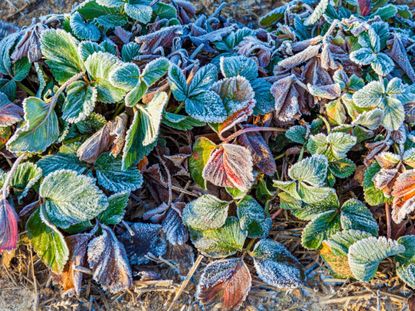Tips For Winterizing Potted Strawberry Plants


Whether grown in pots or outdoor beds, suitable winter care of strawberries is essential. Strawberry plants need to be protected from both cold temperatures and wind in order for them to reproduce each year. Therefore, you'll need to know how to care for your outdoor bed or strawberry plant pot in winter.
How to Over Winter Strawberry Jars
One of the most common questions pertaining to strawberry plants is, “Can you keep strawberries in a strawberry jar over winter?”. The answer is no, not unless you plan on keeping them indoors, well away from any freezing temperatures. For instance, you can move pots to an unheated garage for winterizing potted strawberry plants until the return of spring; however, more often than not they are put in the ground instead. While normally these plants are quite hardy, especially those planted in the ground, keeping them in strawberry pots (or jars) outdoors over winter is not recommended. Most strawberry jars are made of clay or terra cotta. These are not suitable for winter weather as they absorb moisture easily which leads to freezing and makes them more prone to cracking and breaking. This is detrimental to the plants. Plastic pots, on the other hand, withstand the elements better, especially when sunken into the ground. For this reason, strawberry plants are usually removed from their clay containers after the first initial frost and repotted into plastic ones that are at least 6 inches (15 cm.) deep. These are then placed in the ground about 5 ½ inches (14 cm.), leaving the rim sticking up from the soil rather than flush with it. Cover the plants with about 3 to 4 inches (7.5-10 cm.) of straw mulch. Remove the mulch once the plants show signs of growth in spring.
Winterizing Strawberries in Outdoor Beds
Mulch is all you need for winterizing strawberries in beds. The timing for this depends on your location but usually takes place after the first frost in your area. Generally, straw mulch is preferable, though hay or grass can also be used. However, these types of mulch usually contain weed seeds. You'll need to apply anywhere from 3 to 4 inches (7.5-10 cm.) of mulch over the plants, with raised beds receiving somewhat more for additional protection. Once the plants begin growing in early spring, the mulch can be cleared away.
Gardening tips, videos, info and more delivered right to your inbox!
Sign up for the Gardening Know How newsletter today and receive a free download of our DIY eBook "Bring Your Garden Indoors: 13 DIY Projects For Fall And Winter".

Nikki Tilley has been gardening for nearly three decades. The former Senior Editor and Archivist of Gardening Know How, Nikki has also authored six gardening books.
-
 Elegant Exotics: 8 Beautiful Amaryllis Varieties That Will Brighten Any Holiday Display
Elegant Exotics: 8 Beautiful Amaryllis Varieties That Will Brighten Any Holiday DisplayWhether red, pink, white or variegated, the right amaryllis varieties can enhance any living space, especially during the holidays. We round up eight of the most exquisite
By Bonnie L. Grant
-
 Forage For Herbs: 7 Tasty And Safe Wild Herbs To Pick Close To Your Own Backyard
Forage For Herbs: 7 Tasty And Safe Wild Herbs To Pick Close To Your Own BackyardIn addition to growing your own herbal staples, did you know there are several wild options out there that are safe and tasty – and free? Try foraging these 7 wild herbs
By Amy Grant